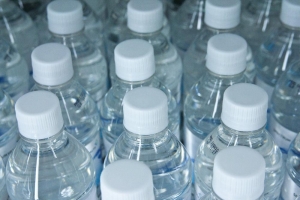Part 3 of 3: Raising awareness: the dangerous truth behind the toxins present in our food supply
BPA: a chemical that plays a role in more than just plastic, but a hormone too!
By now, we’ve all heard about BPA, right? If not, you’re in the right place! In this article, you’ll learn about the history of BPA as a toxin, why it proposes a threat to you and your family’s health, and strategies on how to reduce your exposure.
BPA is an abbreviation for bisphenol A- a chemical used to make hard plastics that are used in many things, from plastic bottles to Tupperware containers to plastic toys to the lining of food and beverage cans. It’s even in thermal paper receipts! BPA permeates our industrialized world, food supply, and modern-day lifestyle.
BPA was first synthesized by chemists 130 years ago. It wasn’t until the 1930s that scientists discovered it had estrogen activity in the body (1). Upon this discovery, BPA was intended to be used as an estrogen replacement drug until a more potent synthetic hormone was invented (1). However, BPA didn’t go anywhere… it found its new role in the future of plastics (1). BPA was first used in the epoxy lining of cans, metal piping, adhesives for flooring and sealing teeth and eventually made its way into plastics in the late 1950s.
In 1958 the FDA passed the Federal Food, Drug, and Cosmetics Act in an attempt to regulate chemicals added to packaged foods. Since BPA was only thought to make its way into food and beverages through leaching of epoxy resin from the lining in cans and showed no indication of being harmful to humans, there was no regulation of BPA in our food supply until 1988.
In 1993 BPA’s estrogenic activity was brought back into the limelight. For the first time, it was proposed as a threat to human health as an endocrine disruptor, meaning it disrupts normal hormonal function, processing, and transmission in the body. Throughout the late 1990s and early 2000s plastic became a political battle with industry lobbyists trying their best to bury the evidence that BPA was, in fact, harmful to human health. By 2005 there were 115 studies on BPA exposure and 90% of them found dangerous health effects of BPA, especially in infants and children. Not surprisingly, the 10% of studies that didn’t find an effect were funded by the plastic industry (2). Major concerns were expressed regarding findings of impaired fetal prostate and mammary gland development, disruption of chromosome alignment in developing eggs, immune system impairment, as well as metabolic and neurological abnormalities (1,2).
Fast forward to 2008 and The Center for the Evaluation of Risks to Human Reproduction released a final report on BPA stating that “the possibility that bisphenol A may alter human development cannot be dismissed”, and that there is “some concern for the effects on the brain, behavior, and prostate gland in fetuses, infants, and children at current human exposure to BPA” (3). Following this report, six of the major baby bottle producers announced the removal of BPA from their products; and in 2012 the FDA finally banned the use of BPA in baby bottles, sippy cups, and epoxy resin in infant formula packaging (4).
However, this chemical is still present and allowed in teethers and children’s play toys. Despite the growing evidence that BPA is harmful in young children, the Toy Association still considers it safe and allows it to be in toys and game products (5).
Today, hundreds of research studies show a relationship between BPA and an increased risk for behavioral disorders like ADHD, anxiety, depression, and aggression in children (6,7).
What’s more, is that the BPA levels originally recognized as safe for human ingestion by the FDA may not be as safe as originally intended. BPA has shown to interact with and bind to thyroid hormone receptors and could play a role in autoimmune thyroid disease (8). Furthermore, BPA has shown to be an obesogenic toxin and is linked to diabetes, weight gain, heart disease, liver inflammation, cancer, and infertility. Disturbingly, a nationwide study found that 89% of individuals ages 6 years and older had detectable levels of BPA in their urine (9).
Here are some actions you can take to minimize your family’s and your own BPA exposure:
- Only purchase baby toys, canned foods (soup, soda, sparkling water, beans, vegetable cans), and Tupperware containers that say “BPA-free” on the label.
- Drink from a reusable stainless steel or glass water bottle instead of plastic ones (this is also better for the environment, so it’s a win-win).
- Don’t microwave leftovers in plastic containers, BPA and other plasticizers (like phthalates) can leak into your food. Instead, transfer the contents to a glass or ceramic bowl or heat on a stovetop if possible.
- Skip the receipt! This will do you and your cashier a favor for reducing toxic BPA (and its cousin BPS) exposure from thermal receipt paper. Simply touching receipts (also boarding passes, tickets) with your hands is enough to absorb it through the skin. Ask for an emailed or text receipt instead! If you need to handle a receipt, wash your hands with soap and water as soon as possible!
These are actions you can take to reduce your BPA exposure! If you have any questions on the impact this chemical has on you or your child’s health, click here and submit a question to our “Ask a Therapist” column and we can answer it in our next newsletter!
These are actions you can take to reduce your BPA exposure right now! If you have any questions on the impact this chemical has on you or your child’s health, click here and submit a question to our “Ask a Therapist” column and we can answer it in our next newsletter!
References:
- Vogel SA. The politics of plastics: the making and unmaking of bisphenol a “safety”. Am J Public Health. 2009;99 Suppl 3(Suppl 3):S559-S566. doi:10.2105/AJPH.2008.159228
- vom Saal FS, Hughes C. An extensive new literature concerning low-dose effects of bisphenol A shows the need for a new risk assessment. Environ Health Perspect. 2005;113(8):926-933. doi:10.1289/ehp.7713
- Shelby MD. NTP-CERHR monograph on the potential human reproductive and developmental effects of bisphenol A. NTP CERHR MON. 2008;(22):.
- https://www.fda.gov/food/food-additives-petitions/bisphenol-bpa-use-food-contact-application
- https://www.toyassociation.org/PressRoom2/IndustryStatements/statement-on-bisphenol-a.aspx#:~:text=It%20has%20been%20specifically%20chosen,items%20has%20been%20phased%20out.
- Li Y, Zhang H, Kuang H, et al. Relationship between bisphenol A exposure and attention-deficit/ hyperactivity disorder: A case-control study for primary school children in Guangzhou, China. Environ Pollut. 2018;235:141-149. doi:10.1016/j.envpol.2017.12.056
- Ejaredar M, Lee Y, Roberts DJ, Sauve R, Dewey D. Bisphenol A exposure and children’s behavior: A systematic review. J Expo Sci Environ Epidemiol. 2017;27(2):175-183. doi:10.1038/jes.2016.8
- Eschler DC, Hasham A, Tomer Y. Cutting edge: the etiology of autoimmune thyroid diseases. Clin Rev Allergy Immunol. 2011;41(2):190-197. doi:10.1007/s12016-010-8245-8
- Lakind, J.S., and D.Q. Naiman. 2008. Bisphenol A (BPA) daily intakes in the United States: estimates from the 2003-2004 NHANES urinary BPA data. Journal of Exposure Science and Environmental Epidemiology 18 (6):608-15.


